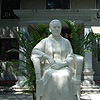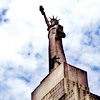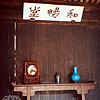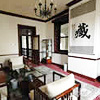On October 10, 1911, the Wuchang Uprising broke out. With one province after another declaring independence from the Qing Dynasty government. As a result, the rule of the Qing Dynasty collapsed, marking an end to the feudal autocratic monarchy of more than 2,000 years and founding the first republic in Chinese history.
To pay tribute to the 100th anniversary of the Chinese Revolution of 1911, with the guidance of Chinese Ministry of Culture, our team designed the photo album which is named "A Century of Change". Through the feature, we will share our insight from our hard work with the readers too.
Sun Yat Sen Memorial Hall 【 2011-09-26 】
Guangzhou Sun Yat-sen Memorial Hall is really a magnificent building in the shape of octangle. It is not only one of the symbolic constructions in Guangzhou with its majestic appearance and the infused rich Chinese national color, but also an important place for large scale meeting and performance.
Old Residence and Tomb of Huang Xing 【 2011-09-24 】
Huang Xing's old residence and mausoleum are located in Changsha City, Hunan Province.
Brief Introduction to Huanghuagang Park 【 2011-09-26 】
On April 27,1911(March 29, Lunar year Xinhai), Tongmenghui, a revolutionary Organization, led by Dr. Sun Yat-sen launched an uprising to overthrow the federal Qing dynasty to build a new democratic country, but unfortunately the effort failed .
A New Gateway to an Old Revolution 【 2011-09-21 】
A girl takes photos of Uprising Gate, on August 16, 2011, in Wuhan, Hubei province. The renovation of Uprising Gate, which is an important site of Xinhai Revolution's Wuchang Uprising in 1911, was completed recently to celebrate the 100th of Xinhai Revolution.
Soong Ching Ling Memorial Residence in Shanghai 【 2011-09-24 】
Soong Ching Ling was the former vice chairman of the People's Republic of China. She devoted her whole life to defending the republic system and the birth of a new China.
Huanghuagang Mausoleum 【 2011-09-24 】
Located in Xianliezhong Road, the Huanghuagang Mausoleum covers an area of 13,200 square meters. It was built in 1912 to commemorate the 72 martyrs died in Guangzhou uprising on April 27,1911.
Old Residence of Qiu Jin 【 2011-09-24 】
The old residence of Qiu Jin is situated No 18 Hechangtang (a place of comfort) at the foot of Zhenta Hill in Shaoxing City, Zhejiang Province.
The Memorial Museum of Generalissimo Sun Yat-sen's Mansion 【 2011-09-24 】
The former site of Generalissimo's Mansion lies in No.18 Dongsha Street, Fangzhi Road, Haizhu District, Guangzhou.
Song Jiaoren’s Residence 【 2011-09-21 】
Located in the northwest corner of Beijing Zoo in Xicheng District, this house is called Changguan Lou. The architecture is typically European and it is the only perfectly preserved Western-style holiday palace of Empress Dowager Cixi.
1、The Preparation of the Revolution
In November 1894, Sun Yat-sen setted up the Xingzhonghui in Honolulu. The next year in February, Sun built the headquarters of Xingzhonghui in Hongkong, and put forward the first guiding principle of the China democratic revolution.
2、The Uprising of the Revolution
The incompetent and corrupt rule of the Qing Dynasty caused extreme anger in Chinese people, finally, In June 1911, the Railway Protection Movement in Sichuan became the trigger of the Chinese Revolution of 1911.
3、The Success and Failure
December 1st, the Qing government signed the armistice with the revolutionary army, and the battle was stopped for three days. This truce is a key turning point that marks the revolution army changed the view from armed struggle to the politics of compromise.
4、Historic
The Chinese Revolution of 1911 is a great bourgeois-democratic revolution, which has far-reaching historic in modern Chinese history.




